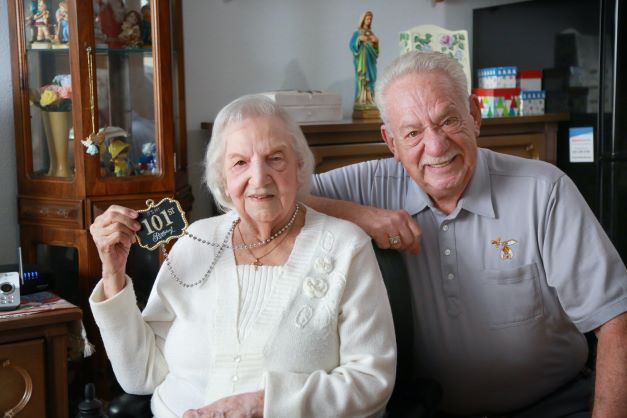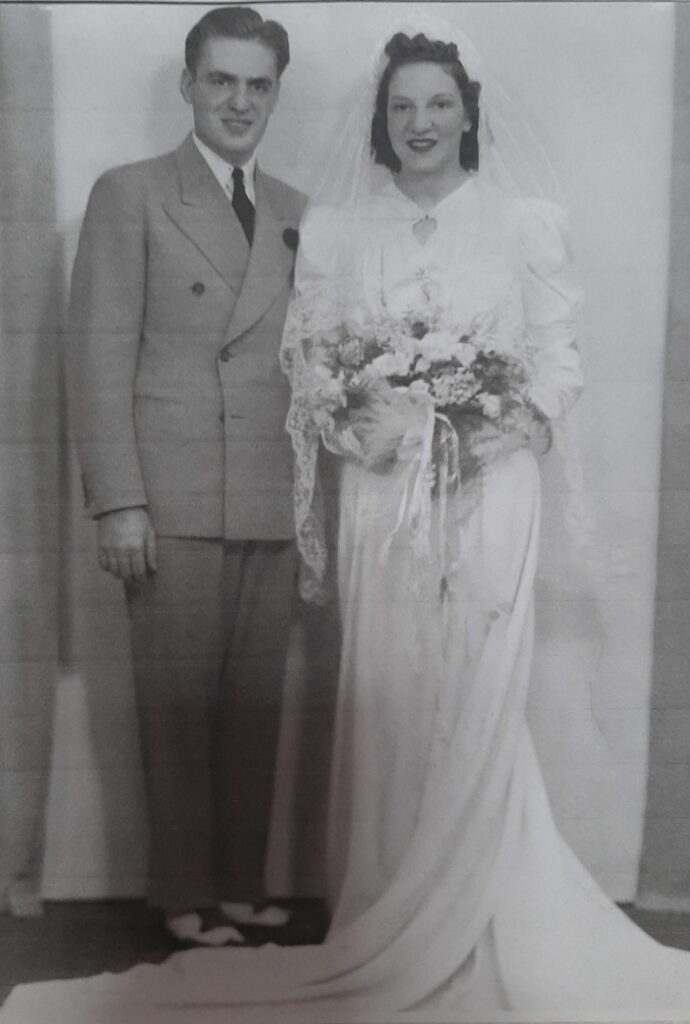
When Lena Dattilo, 101, rolls into the community room at Dayspring Villa, fellow residents yell, “Bingo!” Soon enough— because she’s just that lucky—Dattilo is calling out “Bingo!” herself.
She’s developed a reputation amongst her new neighbors. Dattilo moved to North Denver last year in the midst of the COVID-19 pandemic. But the hardest thing about moving? Getting rid of things and deciding what would fit into her new studio residence.
Dattilo’s son, Tony, created a to-scale drawing of her new space along with cutouts of the furniture she wanted to bring. “Here’s a puzzle for you, mom,” he said. The process was indeed mind-boggling (and Dattilo misses her couch), but she and Tony solved the puzzle beautifully.

She fit a beloved curio cabinet filled with treasures, as well as the cedar chest her husband gave her as a gift in the early days of their life together. It holds her wedding dress, baby books, and other keepsakes that bring back memories or lead on to stories.
How did this centenarian adjust to a move like this, into a small studio after 26 years in her former apartment? In much the same way she adjusted to moving from Michigan to Ohio after her marriage to Anthony “Red” Dattilo in 1940, and then to Utah in 1956 with her husband and two children, Barbara and Tony. And then again in 1957 when the four settled for the duration in Lakewood, Colorado.
“Oh, you can learn to live with it,” she said, with a smile and a shrug.
The Dattilos met, of all places, at a funeral. Red Dattilo had driven up from Columbus, Ohio, to Grand Rapids, Michigan, for the remembrance of an uncle.
“Who else would we know?” Lena Dattilo quipped, “We were never allowed to go out.”
She described a strict Catholic upbringing influenced by Italian old-country ways. In the few dates that were allowed, a chaperone was present. Arranged marriages were not uncommon in the generation before. Lena and Red commenced a long-distance courtship marked by handwritten letters and punctuated by occasional weekend visits.

Red proposed to Lena by letter when he had a ring in-hand and wanted to know if he should bring it with him on his next visit. Dattilo is the youngest, and last surviving, of 11 children born to Sicilian immigrants Pietro and Carmella Geglio.
She married and left her family behind in the Grand Rapids area to move to Columbus where she and Red started their family.
Tony Dattilo, their firstborn, was a young boy as World War II escalated across Europe. He remembers laying in a field near their home, feeling the vibration in his body as planes flew overhead. Thousands of new airplanes, manufactured and finished-off in towns across the Midwest, were flown by Women Accepted for Volunteer Emergency Service (WAVES) to the coasts before deployment to Europe. In those days, Americans of all ages memorized the silhouettes of airplanes in order to distinguish between friendly and threatening aircraft.
Dattilo carried on wherever she lived, leaning on the resourcefulness she learned from parents who had raised children during the Great Depression: homemade bread, egg soup, potato soup. Pietro worked for the streetcar in Grand Rapids until the day he was caught in the crossfire of a feud between neighboring families, costing him his sight in one eye and leaving his memory and speech curtailed.
So, he took up selling veggies from a pushcart while Carmella made full use of every ingredient they could get their hands on. Dattilo laughed as she remembered a neighbor’s potato-whiskey operation, which her mom found ways to leverage. The kids pitched in, of course.
A brother built streets through the New Deal’s Works Progress Administration (WPA). Red’s work in heavy construction meant Dattilo spent many days home with the children, keeping the household and school schedules running smoothly.
She was involved with the church wherever the Dattilos lived, cooking meals for the nuns or helping in the altar society.
Looking at Tony, Dattilo said, “He was a handful, I’ll tell you that. My husband would make a list for the children, lay down the rules.” Tony Dattilo broke in, “Remember those Big Chief tablets? There I was, writing ‘I talked back’ 10,000 times.”
And then, with a chuckle, “Sometimes I held two pencils at a time.”
He may have been a handful back then, but the two make a good pair today. They’ve supported each other through the losses of Red in 1980 and Tony’s younger sister, Barbara, in2010. And they solved the puzzle presented by a massive mid-COVID-19 downsizing.
All as Dattilo turns the corner from 101 toward 102. A few of Dattilo’s things remain in a storage unit.
Some might one day make the trip to the studio for one last look, or a decision of some sort. Or just for a good story, like the autographs of astronauts Ronald Evans, Jack Swigart, Deke Slayton, and Wally Schirra Jr.
The four regularly visited the Little King Ranch near Granby when the Dattilo’s were filling in to help keep the place going in between owners. Little King was a high-end resort at the time, hosting celebrities like Goldie Hawn.
“Remember that one astronaut who had gone into space several times with no problem but would get lost on that ranch every year? “Tony said to his mom. We all laughed. And Dattilo’s advice for her new neighbors in North Denver? “I’d just say, enjoy life. But don’t overdo it.”
Do you have story ideas for The Gray Zone? Email kathryn@denvernorthstar.com.

Be the first to comment